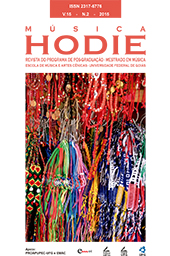The maracá in the beginning of european contact: its role in tupinambá society as a religious token and musical instrument
DOI:
https://doi.org/10.5216/mh.v15i2.39786Resumo
This study draws upon three sixteenth-century primary sources that describe the first-hand impressions of the land and people of Brazil by European travellers. In discussing the religious and social system of the Tupinambá, this study explores the role and significance of music and of the maracá rattle for this peculiar coastal society, as described and depicted by Hans Staden, André Thevet, and Jean de Léry. Although these travel accounts differ in style, approach, and empiric context, they frequently intersect and complement one another, thus helping modern approaches to reconstruct some of the musical idiosyncrasies pertaining to Tupinambá ritual practices. Finally, in analyzing the narrative and iconography in these sources, this study searches for a place for music and the maracá within this complex social system, thus aiming to shed light on its purpose and usage at the time. Keywords: Maracá; Tupinambá; Ritual music; Travel account; 16th century.Downloads
Não há dados estatísticos.
Publicado
2016-02-15
Como Citar
SOLA CHAGAS LIMA, Eduardo. The maracá in the beginning of european contact: its role in tupinambá society as a religious token and musical instrument. Música Hodie, Goiânia, v. 15, n. 2, 2016. DOI: 10.5216/mh.v15i2.39786. Disponível em: https://revistas.ufg.br/musica/article/view/39786. Acesso em: 30 dez. 2025.
Edição
Seção
Artigos















